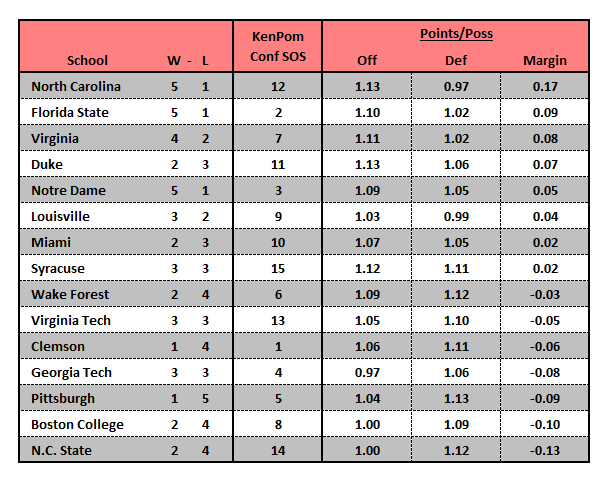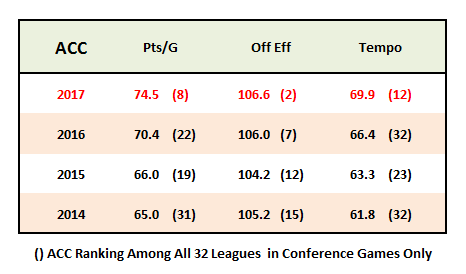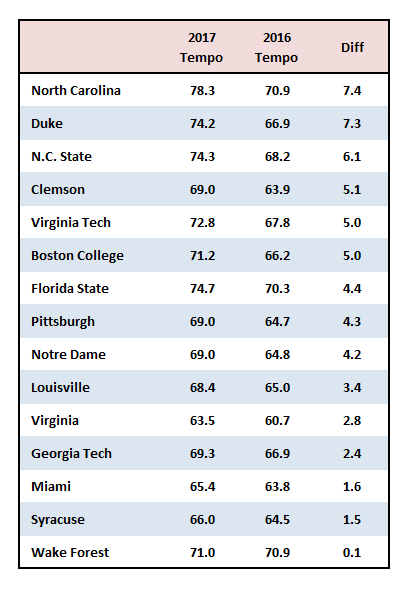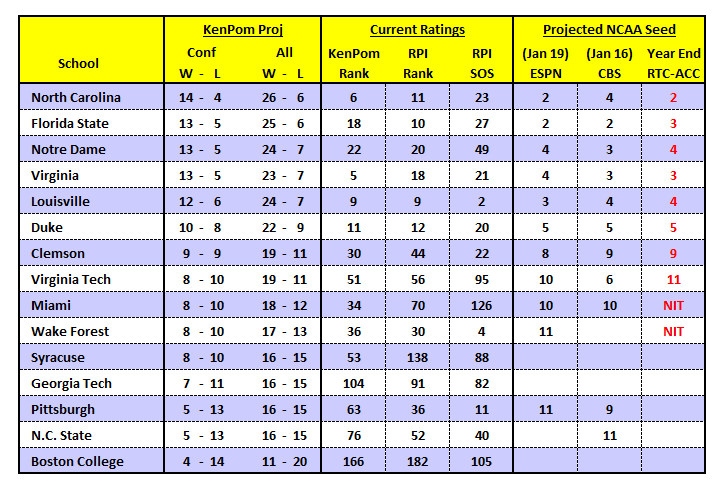Inside the ACC Numbers: Volume I
Posted by Brad Jenkins (@bradjenk) on January 20th, 2017With approximately one-third of conference play now in the books, it’s time to take a closer look inside the ACC numbers. This is the first edition of our weekly look at the current ACC standings with a focus on which teams are playing better or worse than their records may indicate. We will also delve into some advanced metrics to find a few interesting notes on teams, statistics and trends. Finally, we will forecast how the final ACC standings may look given current efficiency margins, and what that may mean for teams’ postseason aspirations.
Note: All numbers are current for games played through Wednesday, January 18.
Current Standings With a sample size of games this small, any one-game extreme performance can really impact the season numbers. This means that some of what we see in the table above is the result of two ACC blowouts — North Carolina’s 51-point rout of N.C. State, and Duke‘s 53-point beating of Georgia Tech. The Tar Heels are currently leading the league in both offensive and defensive efficiency, mostly because of their incredible dominance on the boards. North Carolina’s 44.0 percent offensive rebounding rate in ACC play is even higher than its nation-leading mark for all games (42.7%). Florida State and Notre Dame have achieved great starts (both are 5-1) despite facing two of the three toughest league slates to this point. At the other end of the ledger is Clemson, which has only managed a single win over Wake Forest while playing the toughest conference schedule. The Tigers’ actual performance margin, however, is better than the three squads ahead of them in the standings, so maybe they are not struggling as much as it appears.
With a sample size of games this small, any one-game extreme performance can really impact the season numbers. This means that some of what we see in the table above is the result of two ACC blowouts — North Carolina’s 51-point rout of N.C. State, and Duke‘s 53-point beating of Georgia Tech. The Tar Heels are currently leading the league in both offensive and defensive efficiency, mostly because of their incredible dominance on the boards. North Carolina’s 44.0 percent offensive rebounding rate in ACC play is even higher than its nation-leading mark for all games (42.7%). Florida State and Notre Dame have achieved great starts (both are 5-1) despite facing two of the three toughest league slates to this point. At the other end of the ledger is Clemson, which has only managed a single win over Wake Forest while playing the toughest conference schedule. The Tigers’ actual performance margin, however, is better than the three squads ahead of them in the standings, so maybe they are not struggling as much as it appears.
Advanced Stat of the Week: Tempo Turnaround in the ACC

In a somewhat dramatic turn of events, the ACC has gone from the nation’s slowest league last season to one of the fastest conferences around. When increased pace is combined with the second highest offensive efficiency rating in the country, the result is a significant uptick in league-wide scoring for the second consecutive season. Last year’s increase was attributable to the implementation of new rules such as a 30-second shot clock, greater freedom of movement and extending the no-charge zone near the basket. But with no relevant new rules initiatives coming into play this season, it’s surprising to see the ACC make such a huge leap in scoring. When we break it out further by team, we see that every school in the conference (yes, even Virginia) is playing faster this year. Maybe there’s something in the Gatorade in the Research Triangle because all three area schools are adding quite a few extra possessions this season. Although winning does not appear to correlate with a faster tempo, it will be interesting to see if teams maintain their increased pace going forward. As for why the league is so much faster this season, our best guess is that we are seeing a continued adjustment to the shorter 30-second shot clock. Perhaps it’s as simple as coaches drilling their players to attack the basket a few seconds earlier in the possession to avoid forcing tough shots later.
Maybe there’s something in the Gatorade in the Research Triangle because all three area schools are adding quite a few extra possessions this season. Although winning does not appear to correlate with a faster tempo, it will be interesting to see if teams maintain their increased pace going forward. As for why the league is so much faster this season, our best guess is that we are seeing a continued adjustment to the shorter 30-second shot clock. Perhaps it’s as simple as coaches drilling their players to attack the basket a few seconds earlier in the possession to avoid forcing tough shots later.
Future Forecast

The above table shows predicted order of finish with final regular season records based on KenPom’s current win probabilities for each team. Also included are a few comparative rankings that are mentioned frequently when evaluating NCAA Tournament potential, as well as projections from two bracketology experts — ESPN‘s Joe Lunardi and CBS Sports‘ Jerry Palm. Note that while they project the field as if it was to be named tomorrow, we make our projections based on the final KenPom projected records.
One of the reasons we initially believed that the ACC had a chance for as many as 11 NCAA bids this season is that we did not expect Georgia Tech and Boston College to be competitive with the rest of the league. But instead of allowing the middle of the league to pile up victories at their expense, those two squads are taking wins — and perhaps NCAA at-large invitations — away from the other schools. As our Charlie Maikis pointed out in his ACC Bubble Watch earlier this week, Virginia Tech and Miami are going to be somewhat handcuffed by lousy non-conference schedules. Clemson is in better shape than the others after performing well in November and December, while Syracuse clearly has the most work to do. Wake Forest is a bit of a sleeper but don’t discount the impact of the Demon Deacons’ very high strength of schedule rating.










































